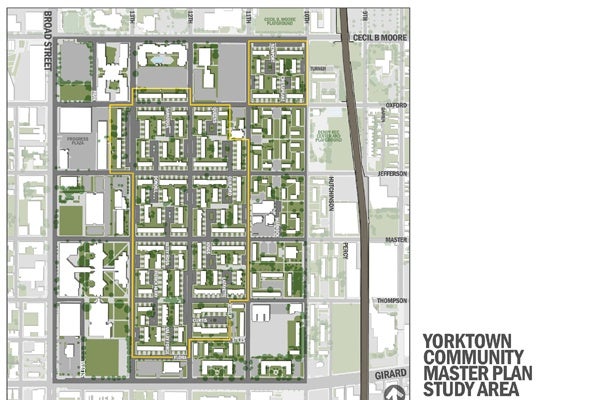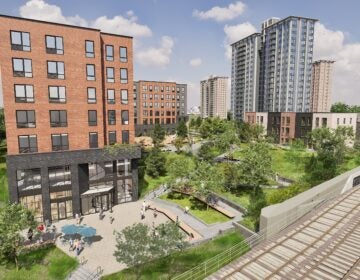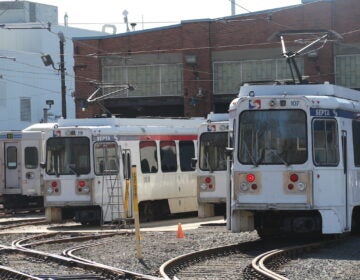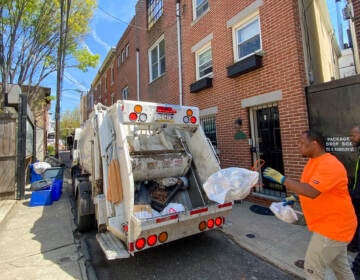North Philly’s Yorktown neighborhood plans for future while getting national honor
It’s almost a cliché to describe Philadelphia as a city of neighborhoods, but when a community right in our backyard receives a national award from the American Planning Association, it’s time to take a closer look.
Since it was built in 1960, the Yorktown neighborhood has been a hub for working class families, professionals, educators and performers.
For some, it took a new historic marker to draw attention to this African-American community characterized by its innovative urban design, it’s stability and sense of identity.
The marker celebrates the life and work one of gospel’s singing royalty: Rosetta Tharpe.
“We are honoring sister Rosetta Tharpe with a marker right here at the house where she lived,” said Philadlephia artist and performer LaDiva Davis.
For Davis this moment last fall, was one to be savored as neighbors, historians and on-lookers gathered around the historic marker. It was also a proud moment for Yorktown’s residents.
Tharpe, died in 1973 and spent the last twelve years of her life in Yorktown. She was one of the first to buy a house in that middle class North Philadelphia neighborhood built in the 1960’s to provide home ownership for African-American families.
Karen Warrington, an artist, dancer, radio personality and communications director for Congressman Bob Brady, remembers when her family bought a house in Yorktown in 1963, where she still lives.
“I think Yorktown is one of Philadelphia’s best kept secrets. It was an experiment that turned out to be a model community that should have been replicated,” said Warrington. “I think all American children who’ve grown up with American literature want to live in a house with a picket fence, a dog and 3.2 children and so this was our chance and part of the American dream.”
Yorktown provided that dream at a time when black families were not welcome in suburbia or some Philadelphia neighborhoods. Yorktown looks like a suburb — two story houses with a garage, porch, small gardens, quiet streets, no businesses or stores. Located near Temple University, between Broad Street and Tenth Street and bordered by Cecil B. Moore and Girard Avenues, it’s easy to miss if you don’t look for it. But not for music entrepreneur Ira Tucker Jr. who in his youth lived on the “other side” of Broad.
“Yorktown was the suburb in North Philly,” said Tucker. “It was something that growing up that I never seen. Grass in front of a house in North Philadelphia? a garage in North Philadelphia?”
The 635 single family homes that make up Yorktown were built in a 153 acres of land that had been razed to get rid of urban blight. When it was time to build a new neighborhood, Reverend William Gray Jr., pastor at the influential Bright Hope Baptist Church, came up with a radical idea.
“The radical idea is that instead of building tenements, tall public housing, what he wanted to do was build middle income houses with home ownership,” said former Congressman William Gray the 3rd, son of Gray Jr.
Also a former pastor at Bright Hope, Congressman Gray spoke about his father’s plan in a film co-produced by Warrington. Bright Hope continues the be a pillar of the community and Rosetta Tharpe sang there regularly.
But with time, the neighborhood started to show its wear. Some of the streets and cul de sacs that belong to the city, have been neglected. As families began selling their homes, residents started to worry.
Tensions grew when some of the houses were subdivided to accommodate Temple University’s ever expanding student population. So Yorktown residents decided to organize to preserve their neighborhood and its legacy. Two years ago, The Yorktown Community Development Corporation commissioned a group of urban designers to make a master plan for the community’s “survival and sustainability”, said Leah Murphy of the urban design firm Interface Studio.
“This unique kind of structure, courtyards, cul-de-sacs and the way that the blocks were laid out became one of the focuses of this plan. How can we restore them to the way they were before so that they become assets to the community rather than isolated eyesores. It’s not necessarily in some ways as it was but it is that strong sense of community has survived,” said Murphy.
Some of the revitalization work is already under way. The rest is progressing slowly but guided by the award-winning plan.
Correction: The commissioning of the survival and sustainability plan referred to in the story was incorrectly attributed to the City of Philadelphia’s redevelopment authority. Also, a resident was misidentified, so his quotation has been removed from the story. We regret the errors.
WHYY is your source for fact-based, in-depth journalism and information. As a nonprofit organization, we rely on financial support from readers like you. Please give today.








